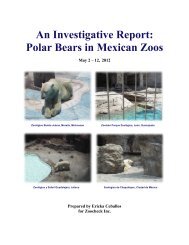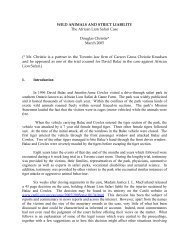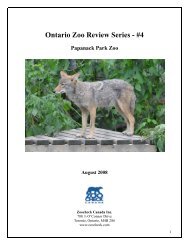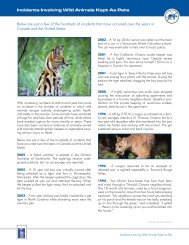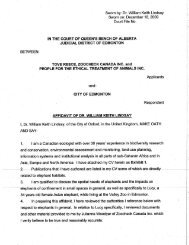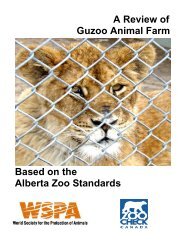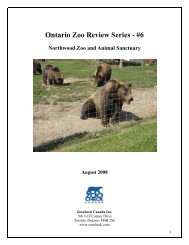STATUS OF BEAR WELFARE
STATUS OF BEAR WELFARE
STATUS OF BEAR WELFARE
Create successful ePaper yourself
Turn your PDF publications into a flip-book with our unique Google optimized e-Paper software.
Status of Bear Welfare in Cherokee, North Carolina<br />
VETERINARY CARE<br />
A complete veterinary care program must include measures to prevent, not just treat, disease,<br />
injury, illness, pain, and suffering, and it must encompass all aspects of an animal’s physical,<br />
mental, and emotional health. The facilities in Cherokee had not established a complete<br />
veterinary care program.<br />
In addition to numerous physical health concerns caused by the improper caging and inadequate<br />
husbandry, the bears endured chronic stress and great psychological suffering. The needs of the<br />
bears were supplanted by the human agenda of running a profitable business in which the<br />
priorities are minimizing overhead (i.e., large numbers of bears in small spaces, low staff costs,<br />
low-maintenance cement enclosures, minimal cage furnishings, and a foodstuff that is<br />
convenient, relatively inexpensive, and easily stored), and providing entertainment value for their<br />
customers (i.e., charismatic wild animals, unobstructed public viewing, and public feedings).<br />
CONCRETE AND RELATED PHYSICAL TRAUMA<br />
Concrete is uniform, abrasive, and unyielding. As such, it contributes to damage to the skeletal<br />
system as well as to muscle strain, circulatory compromise, footpad lesions, callus formation, and<br />
pressure sores.<br />
Although not outwardly obvious, excessive pressure on limbs and tissue leads to bruising,<br />
discomfort, and circulatory compromise. A bear would normally construct a day bed or den by<br />
digging into dirt. Naturally, therefore, a bear’s tissue suffers excessive pressure when the animal<br />
is forced to rest his or her considerable mass on rock-hard surfaces. Similarly, there is the<br />
potential for considerable injury should a bear fall onto a concrete floor, as could occur in the<br />
instance of the cubs at CSBP, who were suspended several feet above the floor when climbing<br />
on the metal door.<br />
Concrete absorbs heat and can cause burns on very hot days. As there was insufficient provision<br />
of shade, save for a shadow occasionally cast by a wall, bears could incur thermal burns when<br />
locked in their outdoor enclosures during the day.<br />
In addition, during hot weather, the heated concrete draws out moisture and oils from the<br />
footpads, encouraging cracks.<br />
Concrete is cleaned with detergents or bleach. Captive animals can suffer chemical burns to their<br />
feet when bleach is under-diluted or left to dry on the concrete before it is rinsed off.<br />
As drainage of the concrete floors of the pits was poor, standing water was a problem. When feet<br />
are not allowed to dry out, they are prone to overhydration and subsequent peeling of the pads.<br />
Standing water is also a breeding ground for infectious agents, which are often antibioticresistant,<br />
and once infections are established, foot problems typically become a chronic issue.<br />
Calluses may build up on the footpads when they are subjected to hard, uniformly unforgiving<br />
artificial surfaces. Heavily callused pads lose their flexibility and their ability to absorb shock.<br />
Consequently, the joints undergo more wear and tear, leading to gradual deterioration and<br />
AN INVESTIGATIVE REPORT <strong>OF</strong> CHIEF SAUNOOKE <strong>BEAR</strong> PARK, CHEROKEE <strong>BEAR</strong> ZOO, AND SANTA’S LAND | 30







